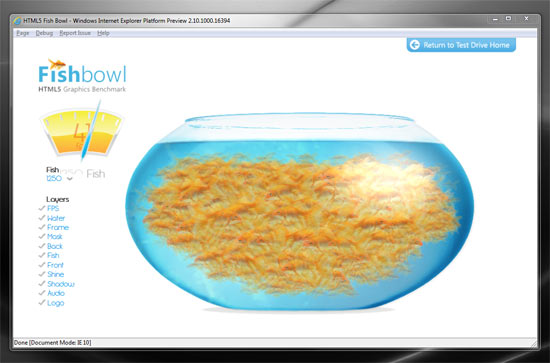Microsoft Releases IE10 Platform Preview 4
Microsoft is now offering the fourth platform preview (PP4) of IE10 for download. The new version demonstrates that IE is no longer trailing the HTML5 trend, but is beginning to help shape the future of web applications.
The improvements in IE10 are almost exclusively tied to JavaScript and CSS3 changes that are part of a future HTML5 platform. Microsoft said that "developers can start working with more site-ready HTML5 technologies" with PP4. The latest version is, like with PP3, only available for the Developer Build of Windows 8. If you are running Windows 7, you will have to stick with PP2, which was released in June and has begun collecting dust.
According to Microsoft, the main changes in PP4 over PP3 are:
- Cross-Origin Resource Sharing (CORS) for safe use of XMLHttpRequest across domains.
- File API Writer support for blobBuilder allowing manipulation of large binary objects in script in the browser.
- Support for JavaScript typed arrays for efficient storage and manipulation of typed data.
- CSS user-select property to control how end-users select elements in a Web page or application.
- Support for HTML5 video text captioning, including time-code, placement, and captioning file formats.
The ongoing additions of HTML5 features had turned IE10 into a browser that can now compete with its rivals in terms of HTML5 support. It is still behind Firefox and Chrome, but IE10 has passed Opera and Safari. When Can I Use shows that IE10 supports 83 percent of HTML5 recommended, proposed, and working draft features. IE9 is at 52 percent, while Firefox is currently at 86 percent, and Chrome at 89 percent. Safari is at 77 percent and Opera at 70 percent.
It is safe to assume that, until the final release, Microsoft will continue on this path and aim to turn IE10 into a compelling HTML5 browser specifically on Windows 8.
Get Tom's Hardware's best news and in-depth reviews, straight to your inbox.

Wolfgang Gruener is an experienced professional in digital strategy and content, specializing in web strategy, content architecture, user experience, and applying AI in content operations within the insurtech industry. His previous roles include Director, Digital Strategy and Content Experience at American Eagle, Managing Editor at TG Daily, and contributing to publications like Tom's Guide and Tom's Hardware.
-
KonstantinDK IE will always be lagging behind if they release new version only every 1-2 years.Reply -
brett1042002 KonstantinDKIE will always be lagging behind if they release new version only every 1-2 years.Reply
So they're supposed to release a new version every week when there is a tiny bug fix?
Sound like any other browsers you know? -
FlayerSlayer So I have to use Windows 8 and that stupid Metro UI if I want to use IE 10, itself a stupid browser? Remind me where the compelling reason is for upgrading to either when Windows 7 and Firefox/Chrome works so well.Reply -
internetlad It's a BROWSER.Reply
Why does it need to be cutting edge? 98 percent of people use it for facebook and/or porn.
Christ. -
joex444 Yawn. The only, ONLY, reason I have Windows 7 installed is to play games. Otherwise I do everything else in Ubuntu.Reply -
Goldengoose internetladIt's a BROWSER.Why does it need to be cutting edge? 98 percent of people use it for facebook and/or porn.Christ.Reply
For general use perhaps - you forget about businesses, large and small, who use it on a day to day basis. -
captaincharisma otacon72What a ridiculous statement. If you have to release a new version every month you have a pretty crappy R&D department.Reply
if you really think its just bug fixes then you really do not know what you are talking about
-
funguseater GoldengooseFor general use perhaps - you forget about businesses, large and small, who use it on a day to day basis.Reply
LOL most company intranets are still based on IE6, I don't think many will be jumping on the IE10 bandwagon for some time...
